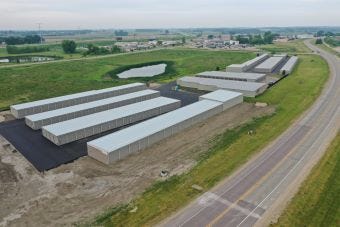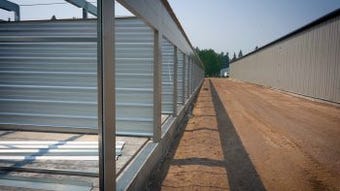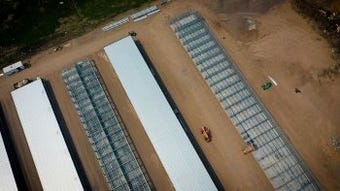Building Your First Self-Storage Facility: A 7-Point Plan to Put You on the Right Path
So, you’re thinking about building your first self-storage project. Where do you start? Here’s a seven-point plan with helpful tips and important considerations. These should help you create a facility that’s positioned to generate steady cash flow and create long-term wealth.
September 13, 2023

As an industry, self-storage has always had a high percentage of independent owner-operators. This is one reason the sector continues to draw interest from small investors and entrepreneurs, particularly those from other areas of commercial real estate. If you’re among those who’ve been thinking about joining the ranks by building a storage facility, following is a seven-step plan to ensure you begin on the right foot. It provides helpful tips and important considerations for developing a project that is financially viable in the long term.
1. Identify a Market (or Two)
Some new owners/investors look to build self-storage near their home, so they can manage the property themselves. It’s convenient and practical. However, don’t limit your property search to your immediate area. Instead, conduct a thorough investigation of multiple markets to determine where there’s sufficient demand and a profitable relationship between construction expenses and rental income.
You’ll quickly realize that land costs and rental rates can vary widely. The latter has the greatest impact on your ability to secure funding and generate profit once your new business is up and running.
In particular, pay attention to areas with growing population, as they’re more likely to experience increased self-storage demand. This means they present opportunities for development.


Land was purchased for Columbus Self Storage in Columbus, Wisconsin in 2019. Sitework began
in late 2022, and the Certificate of Occupancy was issued in June 2023.
2. Learn the Zoning and Permitting Process
When choosing the best parcel for self-storage development, the biggest challenge is often obtaining the necessary permissions from the city. In fact, securing land with the correct zoning designation is a critical hurdle. To ensure a success, research the districts in your target market and identify the ones that permit self-storage. You’ll also need to determine if a conditional-use permit is required. Each jurisdiction may have its own requirements for obtaining this, which can involve expensive planning.
In an ideal scenario, you’ll confirm that you’re allowed to build self-storage on a parcel before investing in various tasks, such as stormwater planning. In reality, your city may require that you provide detailed stormwater planning conducted by a professional civil engineer, along with comprehensive structural plans and artistic renderings of your project, before they’ll give approval. The more information they demand, the more time and money it’ll cost you to meet their requirements.
If you need to attend any public hearings or meetings, it’s highly recommended that you observe other sessions beforehand, so you know what to expect. When your time comes, participate! This’ll give you with valuable insight to the process and help you navigate the proceedings effectively.
3. Make Two Financial Projections: Ballpark and Precise
When embarking on a self-storage development, your initial costs will primarily relate to planning. Any general contractor you consider hiring will need your plans before they can provide you with an accurate bid for the work, so you’ll need to hire civil engineers, surveyors and maybe a feasibility consultant as well as an architect.
Before proceeding with any of this, however, it’s crucial to assess the project’s income potential and determine if it’s a worthwhile investment. Start by making a ballpark estimate. During your early discussions with construction professionals, ask for an approximate cost per square foot. Then research nearby self-storage properties to calculate an estimated income per square foot. With this information, you can create a cash-flow projection that’s sufficient to help you understand project viability.
It’s important to note, however, that this estimate won’t be detailed enough to apply for financing. Once you’ve created a detailed development plan, including building layouts, grading, lighting and landscaping, you can replace your ballpark figure with more precise and detailed proposals. At this point, you’ll have a more accurate understanding of the costs involved, allowing you to proceed with financing and other aspects of the project.


Construction at Legend Trail Storage in Columbia Falls, Montana, in June 2023
4. Set Realistic Timelines
If you aren’t regularly involved in commercial construction, it’s important to understand that everything will likely take longer than anticipated. When taking a step-by-step approach to minimize risk, the timeline for a self-storage development is typically measured in years rather than months. Throughout the process, you may encounter delays related to:
Stormwater management, especially if there are specific regulations or environmental considerations involved
Wetlands, which may require additional surveys and permits
Replatting, which may be required if the boundaries or lot configurations of your land need to be adjusted
Acquiring the required permits from local authorities
Public hearings or community input
Loan approvals, which may involve several stages
A review by the Small Business Administration, if you’re appealing to them for financing or other support
Property appraisal
Seasonal factors such snow or heavy rainfall
Supply-chain issues that impact the ability to secure materials
By anticipating these potential factors, you can better manage your expectations and mitigate their impact on your project timeline.
5. Match the Product to Your Goals
When setting your self-storage construction plans, keep your future goals in mind. For example, if you intend to sell the property to a larger operator, your master plan must support the costs associated with hiring a professional management firm. Maybe you want to establish a series of smaller facilities that can be managed remotely to reduce operating costs.
Whatever your objective, it’s important to choose the right product. There are a few types of self-storage. Each has its own potential.
Standard, drive-up storage is the easiest to build and operate. Popular among developers, it accommodates a variety of unit sizes and configurations. Buildings are typically 30 to 40 feet wide, with 25-foot drive aisles between them.
While slightly more complex and costly to build, climate-controlled storage offers higher rental rates and better land use, opening the door to more profit. The demand for these units is usually higher in affluent markets as well as those that experience wide swings in temperature and humidity. This project may require more initial capital, but it offers a higher return on investment in the long run.
Boat and RV storage involves larger units with wider driveways. The market segment is typically less saturated, which means higher demand and less competition; however, this product also requires a significant amount of land, and the rental rates per square foot are usually lower than those of traditional self-storage. Success relies on your ability to find inexpensive land, minimize site-preparation expenses, and set rental rates at an appropriate level. Large, national self-storage chains tend to avoid this type of storage, too, so if you’re looking to be acquired, it may not be the right choice for you.
6. Understand Remote Management
Remote facility management has become popular in the self-storage industry. With advancements in technology, tasks related to rentals and customer service can easily be handled through websites or automated kiosks. Security can be managed via automatic gate systems, mobile apps, keypads, electronic locks and surveillance cameras. This avoids the need for onsite staff, even for important duties like applying and removing unit overlocks. Outsourcing certain jobs, such as lawn care and snow removal, is also possible.
That said, even a remotely managed facility requires regular visits from a manager or owner to monitor suspicious activity, remove litter, clean vacant units and handle occasional issues. While today’s technology can streamline operation and reduce the need for full-time employees, it doesn’t completely eliminate the need for a human presence.
For smaller self-storage operations or those with tighter budgets, remote management may require patience and strategy. Try planning your project in phases, allowing for the eventual addition of desired features. For example, leave a place for a future kiosk or install a conduit for a gate system that may be incorporated in phase two. This allows you to adapt and expand your management capabilities as your facility grows or market demands change.
7. Plan Carefully
It’s crucial to listen to the advice of your self-storage construction vendors, who possess valuable experience and expertise. Before ordering materials, collaborate with each member of your development team to thoroughly refine all aspects of the project, including:
Building position
Location of gates and fences
Mechanical requirements
Power needs for internet repeaters and networking equipment
Surveillance-camera and lighting placement
Vehicle navigation
Stormwater management
Snow placement/removal
Plan meticulously, so you can minimize changes once the project is underway. Lack of communication and mid-project alterations are often the cause of mistakes that can lead to delays and increased costs. For instance, failing to clearly document bollards for the sitework team up front or adding last-minute steps to the grading plan without considering the impact on building components can result in errors and setbacks.
The goal is to establish a self-storage business that generates steady cash flow and creates long-term wealth. This isn’t a get-rich-quick scheme but rather a venture that requires a long-term perspective. With proper planning and implementation, you can build a successful operation that, after three or four years, leaves you amazed at your accomplishments. Taking a leap of faith and planning carefully during the construction process are key to achieving your dream.
Steve Hajewski is regional manager for Trachte Building Systems, which designs, manufactures and erects a full line of pre-engineered and customized steel self-storage systems, including single- and multi-story, portable storage, interior partition and corridor, and canopy boat/RV. He’s also a partner of three facilities in Wisconsin and a frequent contributor on Self-Storage Talk, the industry's largest online community. For more information, call 800.356.5824.
About the Author(s)
You May Also Like





